Horse Shoe Spread
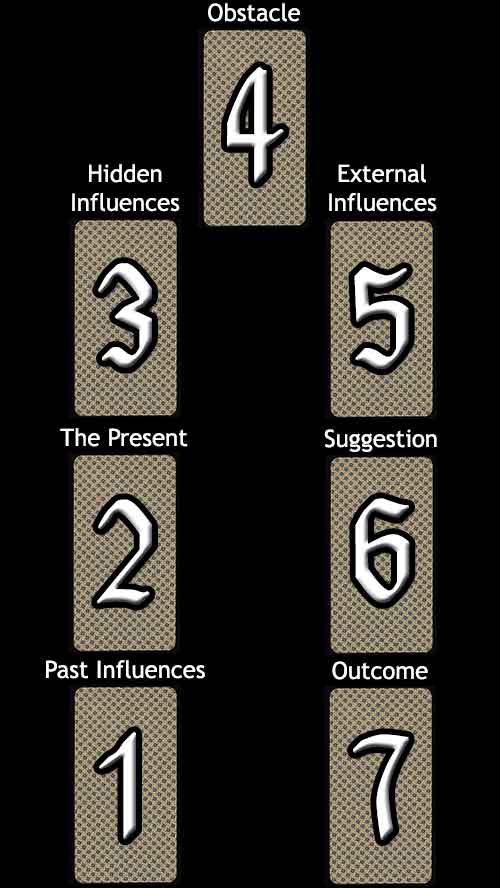
Difficulty: Easy
The Horse Shoe is a classic tarot spread. It is more advanced than the three-card reading, yet simpler than most other spreads. It is a versatile method that can be used for most queries, though there are other spreads which would go into more depth. Like the simple Past, Present, and Future spread, it contains these cards in positions #1, #2, and #7, but also has four other tarot cards that help the reader understand how to deal with the future better. The cards are to be read as follows:
- The Past: Past events affecting the question.
- The Present: The current state or approaching influence.
- Hidden Influences: Things the reader may not be aware of (or barely be aware of).
- Obstacles: This is the challenge: obstacles may be avoided or may have to be dealt with.
- External Influences: Attitudes and thoughts regarding people around the reader.
- Suggestions: Recommended course of action.
- Outcome: The result of following the suggestions.
Your Horse Shoe Reading
Obstacle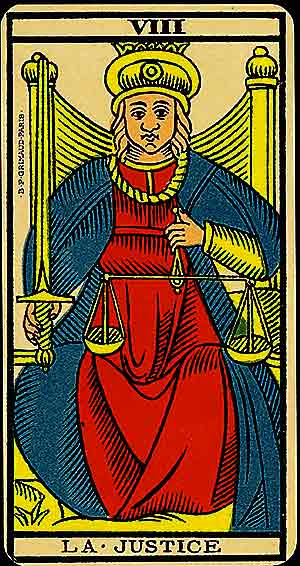 VIII – Justice |
||
Hidden Influences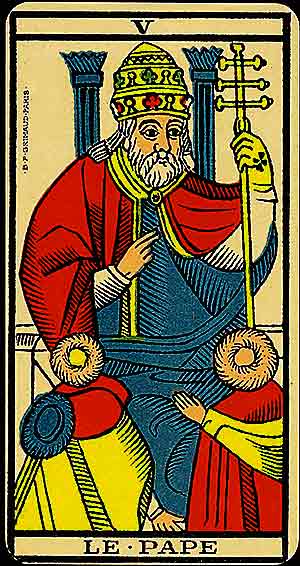 V – The Pope (Le Pape) |
External Influences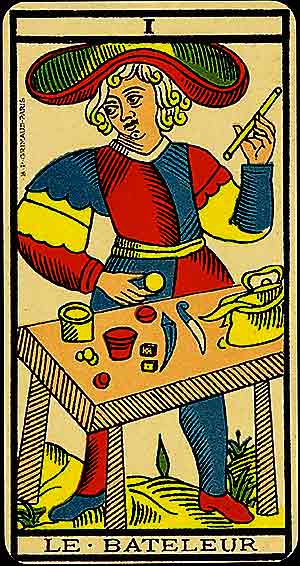 I – The Magician (Le Bateleur) |
|
The Present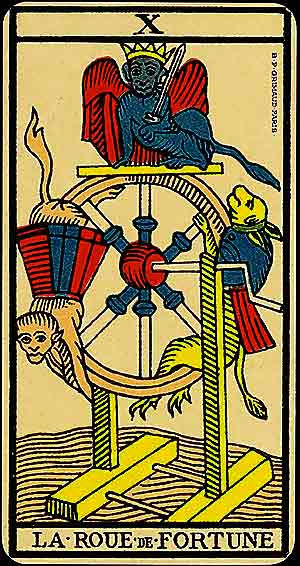 X – The Wheel of Fortune (La Roue de Fortune) |
Suggestion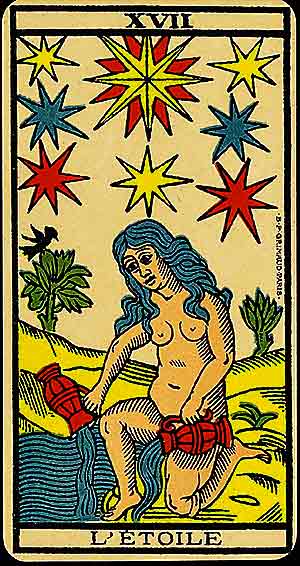 XVII – The Star (L'Étoile) |
|
The Past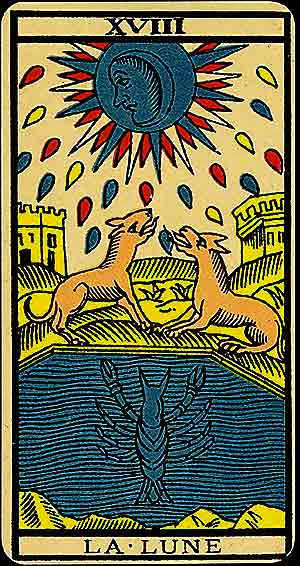 XVIII – The Moon (La Lune) |
The Outcome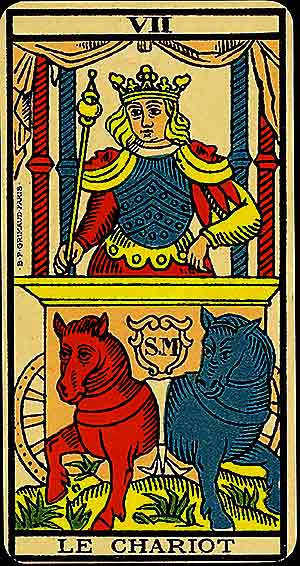 VII – The Chariot |

The Past Card represents past events that are affecting the question.
XVIII – The Moon (La Lune)
The Moon symbolises intuition, mystery, and the subconscious. It reflects the realm of dreams, illusions, and emotions, inviting you to explore the depths of your psyche and confront hidden truths.
Symbolism: The Moon casts its dim light over a mysterious scene: a dog and a wolf howl beneath its glow, representing the duality of tame and wild instincts. A crayfish emerges from the water, symbolising the hidden depths of the subconscious rising to the surface. The two towers suggest boundaries between reality and the unknown.
In Relationships: Emotional complexity, hidden dynamics, or the need to trust your intuition. Beware of illusions or misunderstandings.
In Work: A period of uncertainty or unclear direction. It encourages careful reflection and trusting inner instincts over external noise.
Spiritually: The Moon calls for introspection and exploration of the shadow self through dreams, intuition, and subconscious symbols.
When ill-dignified: Confusion, deception, or fear of the unknown. It warns against being lost in illusions or succumbing to anxiety.

The Present Card represents the current state or immediately approaching influence.
X – The Wheel of Fortune (La Roue de Fortune)
The Wheel of Fortune symbolises the ever-turning cycles of life, fate, and destiny. It teaches the importance of adaptability and trust in the rhythms of change.
Symbolism: The wheel is adorned with figures ascending and descending, representing the rise and fall of fortunes. Its circular motion evokes the cyclical nature of existence, while divine forces implied by the card's design suggest that some aspects of life are beyond human control.
In Relationships: Changes in relationship dynamics or the appearance of new opportunities. Trust in the flow of events.
In Work: A shift in circumstances, often bringing unexpected opportunities. Stay flexible and open to change.
Spiritually: The Wheel of Fortune reflects the interconnectedness of life's cycles, encouraging surrender to the divine plan.
When ill-dignified: Resistance to change or clinging to outdated patterns. It warns of losing perspective during times of transition.

Hidden Influences - Things that you may not be aware of, or barely be aware of.
V – The Pope (Le Pape)
The Hierophant bridges the earthly and the divine, symbolising tradition, spiritual guidance, and the transmission of sacred knowledge. He represents the connection between the seeker and a higher truth through structure and ritual.
Symbolism: The Hierophant sits between two pillars, a gesture of blessing extended towards two kneeling figures below him. His triple cross sceptre represents spiritual authority, while the two fingers pointing to his heart suggest access to divine mysteries. His serene expression reflects wisdom tempered with compassion.
In Relationships: A relationship built on shared values. It can also signify guidance or mentorship within a partnership.
In Work: Success through adherence to structure, tradition, or established methods. Seek advice from a mentor or institution.
Spiritually: The Hierophant invites the seeker to explore established spiritual paths, finding wisdom in teachings passed down through generations.
When ill-dignified: Dogmatism, resistance to change, or blind adherence to tradition. It warns against sacrificing individuality for conformity.

Obstacle - This is the challenge.
VIII – Justice
Justice signifies truth, balance, and the law of cause and effect. She represents the impartial hand of the universe, delivering outcomes that align with one's actions and intentions.
Symbolism: Seated on a throne, Justice holds scales in one hand and a sword in the other. The scales symbolise balance and fairness, while the sword represents the clarity and decisiveness required to enact justice. Her direct gaze emphasises accountability and integrity.
In Relationships: Honest communication and equitable partnerships. It calls for evaluating the fairness and balance within relationships.
In Work: Decisions made with integrity will lead to just rewards. It is a time to act ethically and weigh all options carefully.
Spiritually: Justice reflects the law of karma and encourages alignment with higher principles to achieve spiritual clarity.
When ill-dignified: Corruption, dishonesty, or imbalance. It warns against biased decisions or failure to take responsibility for your actions.

External Influences - Attitudes about this situation from people around the querent.
I – The Magician (Le Bateleur)
The Magician represents skill, potential, and the power to shape reality. As the first step in the Major Arcana, he symbolises the individual's awareness of their tools and the initiation of personal mastery.
Symbolism: The table before him holds simple tools—a cup, a coin, a blade, and a wand—representing the raw elements of life and their mastery. His wide-brimmed hat, resembling the lemniscate, speaks of infinite potential and dynamic creativity. The uneven terrain below mirrors his capacity to balance uncertainty with control.
In Relationships: A time to take initiative or charm your way into new connections. The Magician highlights personal magnetism but warns against manipulation.
In Work: A signal to harness your skills and capitalise on emerging opportunities. Confidence and action are key.
Spiritually: The Magician is the bridge between spirit and matter, teaching you to use divine gifts responsibly.
When ill-dignified: Deception, arrogance, or scattered energy. It warns against using talents for selfish or destructive ends.

Suggestion - The recommended course of action.
XVII – The Star (L'Étoile)
The Star is a card of hope, inspiration, and renewal. It symbolises divine guidance and the gentle flow of healing energy after hardship.
Symbolism: A nude figure kneels beside a stream, pouring water onto the land and back into the source, representing the cyclical nature of renewal and the flow of inspiration. Above her, stars shine brightly, offering hope and illumination.
In Relationships: Healing and harmony. It suggests vulnerability and openness to connection.
In Work: Inspiration and the emergence of new opportunities. A time for trust in your creative vision.
Spiritually: The Star invites you to align with your higher purpose, finding peace in the guidance of the cosmos.
When ill-dignified: Doubt, loss of faith, or feeling disconnected from inspiration. It warns against losing hope during challenging times.

The Outcome - What will happen if the suggestion is followed.
VII – The Chariot
The Chariot represents triumph through willpower and discipline. It is the card of focused determination, suggesting the mastery of opposing forces to achieve a unified goal.
Symbolism: The charioteer stands tall, guiding two horses of contrasting colours, symbolising duality and control. The canopy above him evokes divine protection, while the wheels in motion reflect progress and momentum. His expression is resolute, embodying control amidst dynamic movement.
In Relationships: Moving forward together, overcoming challenges, or achieving harmony despite differences.
In Work: Success through focus, persistence, and strategic action. Victory is attainable through balance and self-control.
Spiritually: The Chariot teaches the alignment of inner and outer forces, calling for the integration of spirit and will to advance.
When ill-dignified: Lack of direction, recklessness, or internal conflict. It warns against being pulled in opposing directions without clarity of purpose.